InFocus IN81 DLP Projector Review
InFocus IN81 DLP Projector
Filling the gap between InFocus' top entertainment model and its lower-specced range is the IN81. Any good, John?
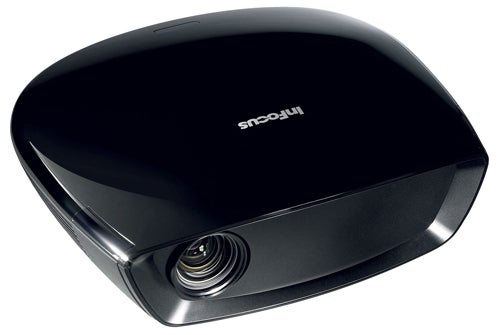
Verdict
Key Specifications
- Review Price: £1999.00
Supremely excellent though it undoubtedly is, the InFocus IN82 projector we reviewed a few weeks back was hardly within the grasp of your average AV-loving man on the street. Despite the fact that in many ways its £3,000 asking price actually represents very good value. We also couldn’t help but notice that it left a rather hefty gap in InFocus’s latest projector range between itself and its lower-spec IN78/76/74 models.
So it’s no surprise to find InFocus plugging that gap and trying to cater for a larger HD-loving audience with the £2,000, full HD IN81.
The first bit of good news concerning the IN81 is that it’s actually only just become £2,000 from an original launch price of £2,500, so already our ‘bargain’ radar is bleeping. It’s also a very attractive bit of kit, following the established InFocus fancy for a rounded (to the point of almost being circular) design, finished in glossy black with the main body mounted on a rotating, tilting joint connected to a supporting foot.
The idea behind this unusual jointed mount is that it should make the IN81 particularly easy to set up in even the most oddly shaped of living/cinema rooms. And it proved its worth for the most part, as we managed to get a workable image on our screen from all manner of tricky positions around our test rooms.
The only little niggle about this design idea is that we found it a little tricky to make fine adjustments to the projector’s tilt angle – though with a bit of to-ing and fro-ing, you do always manage to get there in the end.
More user friendliness can be found in the IN81’s attractive and clearly structured onscreen menus, navigated by a basic but eminently logical backlit remote control.
Keeping the good times rolling are two HD digital inputs: one standard HDMI job, and an unusual M1-DA jack. This rather clever little chap is able to take – via the right adaptors – pretty much any feed type – analogue or digital, PC or video – that you might care to throw at it. An HDMI adaptor is thoughtfully included with the projector, incidentally, so it is a genuine ‘two HDMI’ device out of the box.
It’s good to note, too, that the digital inputs are v1.3s able to take the eagerly awaited Deep Colour picture format. Amazingly a Deep Colour source is finally on the horizon, in the form of JVC’s upcoming HD5 and HD6 Everio camcorders. Due to launch in March, these will record in full HD using Deep Colour, and carry HDMI v1.3 outputs to send your Deep Colour recordings to the IN81 – or whatever v1.3-capable screen you happen to own.
There’s still no word on Deep Colour movie discs, though; at the moment it looks like if you want Deep Colour films, you’re going to have to make them yourself!
Anyway, I digress. Getting back to the job in hand, I should also add that the digital video ports can take the in-vogue 1080p/24fps HD format from HD disc players capable of outputting it. Plus they’re joined by dedicated component, S-Video and composite video fallbacks and handy 12V trigger outputs for driving a motorised screen.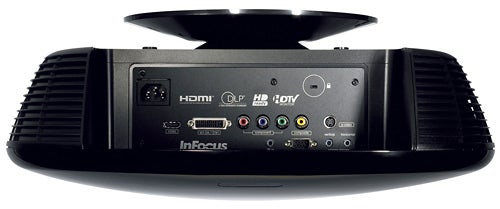
As with all of InFocus’s recent projectors, the IN81’s video processing is taken on by the third-party 10-bit DNX system from PixelWorks – no bad thing considering what impressive results this system has delivered for InFocus so far.
The DLP engine that PixelWorks is driving is, as we indicated earlier, a 1,920 x 1,080 ‘full HD’ one that can apparently produce a contrast ratio of between 3,000 and 10,000:1. Why the different contrast ratio figures? Because the IN81 comes with a manually adjustable iris, allowing you to choose to sacrifice a little of the image’s brightness in return for enhanced black levels.
We have to say that the InFocus idea of quoting a kind of minimum and maximum contrast ratio, rather than just the maximum figure, is admirably honest, and a policy we’d really like its rivals to adopt. Not that they will, of course.
Joining PixelWorks in attempting to improve picture quality, meanwhile, is the software component of Texas Instruments’ BrilliantColor feature, designed to produce richer and more natural colours. To get the full benefit of BrilliantColor, the IN81 would also have needed to use a six-colour colour wheel rather than a standard RGB one; but even just the processing ‘half’ of the system should elicit some positive results.
Other features of note, meanwhile, include a set of thematic gamma presets to suit different types of source, huge amounts of colour fine-tuning, and the facility to remove overscanning from the projector’s presentation of the picture if you’re wanting to watch a full HD source in its purest form.
By the way, if any of this is starting to sound a bit complicated to you, fear not; impressively, for such an affordable projector, the IN81 has all the facilities you need to have it professionally calibrated to suit your specific room conditions by a qualified Imaging Science Foundation engineer.
At this point it’s probably worth looking for what exactly sets the IN81 apart from its costlier brother, the IN82. Basically, the key differences lie in two areas: the chipset at the projectors’ hearts, and the image’s maximum brightness.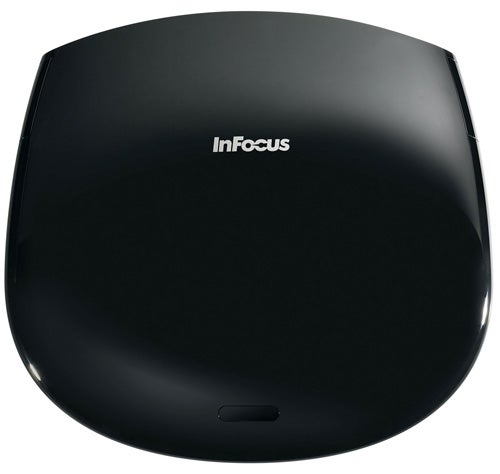
Regarding the chipset, while the IN82 had Texas Instruments’ top of the class DarkChip3 chipset, the IN81 only has the slightly older, less contrast-friendly DarkChip2 chip. As a result, the IN81 ‘only’ claims, as we’ve seen, a still very respectable 3,000:1 native contrast ratio versus 4,000:1 for the IN82. Or with the projector’s iris adjustments called into play, the IN81’s claimed contrast ratio rises to 10,000:1 versus 12,000:1 for the IN82.
It’s also possible that the difference in chipset will deliver slightly less clean motion handling on the IN81, on account of the DarkChip2 system not responding quite as quickly as the DarkChip3 one.
As for the brightness difference, that finds the IN81’s ANSI Lumens rating coming in at 1,400 versus 1,500 on the IN82.
This latter difference, we’ll grant you, doesn’t sound like an awful lot on paper. But there’s no getting round the fact that in practice, the IN81’s images do actually appear less bright than the IN82’s. This means they definitely lack a little of the sparkle and lustre of the more expensive model, and immediately make the IN82 the machine of choice if your budget can stretch to it.
However, despite this seemingly rather negative opening gambit, we’re not trying to suggest that the IN81 is not an excellent projector in its own right. Far from it. The situation we just described says far more about the outstanding strengths of the IN82 than it does weaknesses in the IN81.
For instance, compared to rivals at its £2,000 price point, at least the DLP ones, the IN81’s pictures are pretty bright and dynamic. What’s more, this brightness doesn’t seem to have necessitated as many black level compromises as you’d normally expect of such a relatively affordable projector. For instance, the darkest corners of J.F. Sebastian’s apartment during the final face-off of ”Blade Runner” suffer remarkably little from the greying over we’d expect of such a cost-effective projector – especially one sporting a DarkChip2 DLP system.
Even better, there’s nothing at all forced about the IN81’s black level depth. Which is to say that dark areas don’t just look like empty black holes, but rather contain all the subtle colours and background details that make them feel like fully integrated parts of the picture as a whole.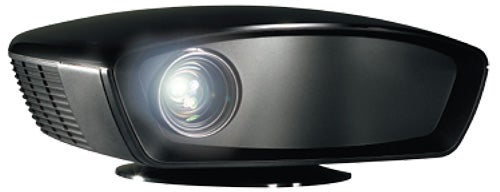
Another string to the IN81’s bow is its colour handling. The vivid animated neon advertising hoardings in ”Blade Runner” look exceptionally vibrant and aggressive. And as for the film’s tricky-to-render skin tones these, as lit by the ever-changing artificial lighting of Ridley Scott’s futuristic city, tend to look surprisingly authentic – albeit not quite so outstandingly credible as with the IN82.
Yet more good news comes from the IN81’s full HD pixel count. In other words, its HD pictures are terrifically detailed, clean, and sharp. Every leaf, for instance, of the ”Lost” jungle and every bit of stubble on its leading men’s faces are immaculately rendered. It’s also notable how impressively smooth blended colour transitions tend to look.
With the IN81 only very occasionally revealing the odd bit of DLP’s ‘rainbow effect’ (where bands of pure red, green and blue flicker round your peripheral vision or over particularly bright parts of the picture), we’re really struggling to find anything bad to say about it considering its price. Perhaps, at a push, we might say it could run a little quieter. But heck; a little bit more fan noise than we might ideally want to hear doesn’t even get within a million miles of being a deal breaker when there’s so much other cool stuff on offer for your two grand.
”’Verdict”’
Does the IN81 fall short of the glories of the InFocus IN82? Yes it does. But does it nonetheless outperform its £2k asking price by a country mile? You’d better believe it.
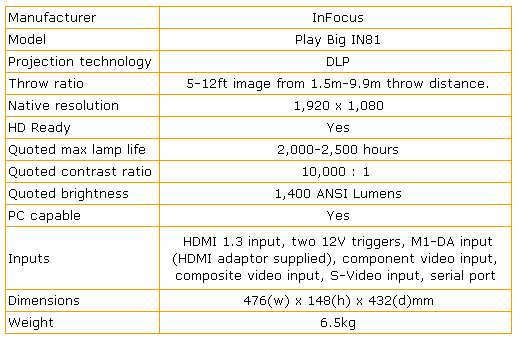
How we test televisions
We test every TV we review thoroughly over an extended period of time. We use industry standard tests to compare features properly. We’ll always tell you what we find. We never, ever, accept money to review a product.
Trusted Score
Score in detail
-
Value 10
-
Image Quality 8

